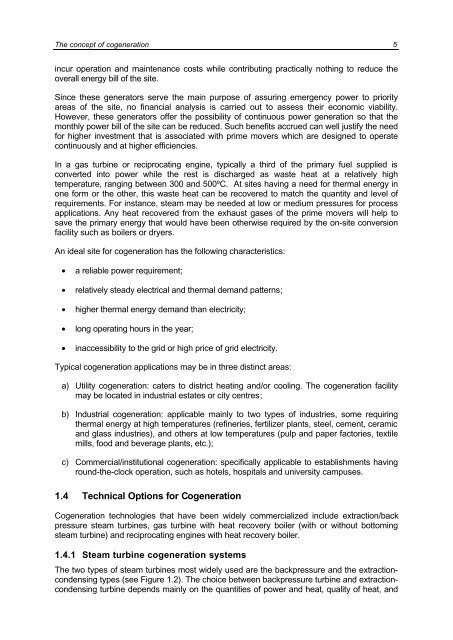part 1: overview of cogeneration and its status in asia - Fire
part 1: overview of cogeneration and its status in asia - Fire
part 1: overview of cogeneration and its status in asia - Fire
Create successful ePaper yourself
Turn your PDF publications into a flip-book with our unique Google optimized e-Paper software.
The concept <strong>of</strong> <strong>cogeneration</strong> 5<br />
<strong>in</strong>cur operation <strong>and</strong> ma<strong>in</strong>tenance costs while contribut<strong>in</strong>g practically noth<strong>in</strong>g to reduce the<br />
overall energy bill <strong>of</strong> the site.<br />
S<strong>in</strong>ce these generators serve the ma<strong>in</strong> purpose <strong>of</strong> assur<strong>in</strong>g emergency power to priority<br />
areas <strong>of</strong> the site, no f<strong>in</strong>ancial analysis is carried out to assess their economic viability.<br />
However, these generators <strong>of</strong>fer the possibility <strong>of</strong> cont<strong>in</strong>uous power generation so that the<br />
monthly power bill <strong>of</strong> the site can be reduced. Such benef<strong>its</strong> accrued can well justify the need<br />
for higher <strong>in</strong>vestment that is associated with prime movers which are designed to operate<br />
cont<strong>in</strong>uously <strong>and</strong> at higher efficiencies.<br />
In a gas turb<strong>in</strong>e or reciprocat<strong>in</strong>g eng<strong>in</strong>e, typically a third <strong>of</strong> the primary fuel supplied is<br />
converted <strong>in</strong>to power while the rest is discharged as waste heat at a relatively high<br />
temperature, rang<strong>in</strong>g between 300 <strong>and</strong> 500ºC. At sites hav<strong>in</strong>g a need for thermal energy <strong>in</strong><br />
one form or the other, this waste heat can be recovered to match the quantity <strong>and</strong> level <strong>of</strong><br />
requirements. For <strong>in</strong>stance, steam may be needed at low or medium pressures for process<br />
applications. Any heat recovered from the exhaust gases <strong>of</strong> the prime movers will help to<br />
save the primary energy that would have been otherwise required by the on-site conversion<br />
facility such as boilers or dryers.<br />
An ideal site for <strong>cogeneration</strong> has the follow<strong>in</strong>g characteristics:<br />
• a reliable power requirement;<br />
• relatively steady electrical <strong>and</strong> thermal dem<strong>and</strong> patterns;<br />
• higher thermal energy dem<strong>and</strong> than electricity;<br />
• long operat<strong>in</strong>g hours <strong>in</strong> the year;<br />
• <strong>in</strong>accessibility to the grid or high price <strong>of</strong> grid electricity.<br />
Typical <strong>cogeneration</strong> applications may be <strong>in</strong> three dist<strong>in</strong>ct areas:<br />
a) Utility <strong>cogeneration</strong>: caters to district heat<strong>in</strong>g <strong>and</strong>/or cool<strong>in</strong>g. The <strong>cogeneration</strong> facility<br />
may be located <strong>in</strong> <strong>in</strong>dustrial estates or city centres;<br />
b) Industrial <strong>cogeneration</strong>: applicable ma<strong>in</strong>ly to two types <strong>of</strong> <strong>in</strong>dustries, some requir<strong>in</strong>g<br />
thermal energy at high temperatures (ref<strong>in</strong>eries, fertilizer plants, steel, cement, ceramic<br />
<strong>and</strong> glass <strong>in</strong>dustries), <strong>and</strong> others at low temperatures (pulp <strong>and</strong> paper factories, textile<br />
mills, food <strong>and</strong> beverage plants, etc.);<br />
c) Commercial/<strong>in</strong>stitutional <strong>cogeneration</strong>: specifically applicable to establishments hav<strong>in</strong>g<br />
round-the-clock operation, such as hotels, hospitals <strong>and</strong> university campuses.<br />
1.4 Technical Options for Cogeneration<br />
Cogeneration technologies that have been widely commercialized <strong>in</strong>clude extraction/back<br />
pressure steam turb<strong>in</strong>es, gas turb<strong>in</strong>e with heat recovery boiler (with or without bottom<strong>in</strong>g<br />
steam turb<strong>in</strong>e) <strong>and</strong> reciprocat<strong>in</strong>g eng<strong>in</strong>es with heat recovery boiler.<br />
1.4.1 Steam turb<strong>in</strong>e <strong>cogeneration</strong> systems<br />
The two types <strong>of</strong> steam turb<strong>in</strong>es most widely used are the backpressure <strong>and</strong> the extractioncondens<strong>in</strong>g<br />
types (see Figure 1.2). The choice between backpressure turb<strong>in</strong>e <strong>and</strong> extractioncondens<strong>in</strong>g<br />
turb<strong>in</strong>e depends ma<strong>in</strong>ly on the quantities <strong>of</strong> power <strong>and</strong> heat, quality <strong>of</strong> heat, <strong>and</strong>









